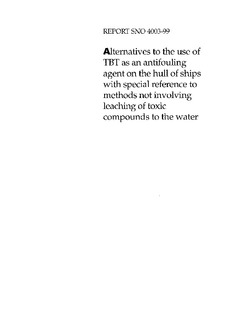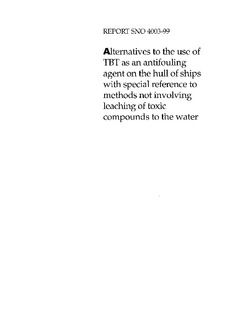| dc.contributor.author | Berge, John Arthur | |
| dc.contributor.author | Walday, Mats | |
| dc.contributor.other | Berge, John Arthur - Project manager | |
| dc.date.accessioned | 2015-01-27T10:11:49Z | |
| dc.date.available | 2015-01-27T10:11:49Z | |
| dc.date.issued | 1999 | |
| dc.identifier | 4003 | |
| dc.identifier.isbn | 82-577-3601-5 | |
| dc.identifier.issn | 1894-7948 | |
| dc.identifier.uri | http://hdl.handle.net/11250/274768 | |
| dc.description.abstract | The International Maritime Organisation has agreed on a plan to ban the use of organotin for antifouling on large ships. Basic elements in the plan are: no new application of paint containing organotin after 1st January 2003. No use of organotin in antifouling systems for ships after 1st January 2008. This plan implies that alternatives to TBT must be available to the shipping industry within 2003. Various non-toxic antifouling strategies have been elucidated. At present there seems to be no good biocide free method ready to use for all types of vessels. Siliconbased non-toxic systems are available for ships with a speed of more than 15 knots. At present slower ships will have to be regularly cleaned or have to rely on biocidal systems. It is expected that biocides will be a part of antifouling systems on slow ships for many years. The use of copper-nickel hull and the electrolytic approach seems to have some potential. An obstacle for the use of these two approaches is that they are toxic in nature. Antifouling systems based on compounds found in marine organisms are promising on long term basis. The development of a complete antifouling system based on such naturally occurring compounds lies at least 5 years ahead. The use of information from research on natural products to design new antifouling paints, does a priori, not necessarily infer that the active ingredient is "environmentally sound". Such compounds therefore should be tested for possible environmental effects. A further development of such tests is a recommended area of future research. | nb_NO |
| dc.description.sponsorship | Norwegian Maritime Directorate (NMD) | nb_NO |
| dc.language.iso | eng | nb_NO |
| dc.publisher | Norsk institutt for vannforskning | nb_NO |
| dc.relation.ispartofseries | NIVA-rapport;4003 | |
| dc.rights | Navngivelse-Ikkekommersiell-DelPåSammeVilkår 3.0 Norge | * |
| dc.rights.uri | http://creativecommons.org/licenses/by-nc-sa/3.0/no/ | * |
| dc.subject | Tributyltin / Tributyltin | nb_NO |
| dc.subject | Antibegroing / Antifouling | nb_NO |
| dc.subject | Skip / Ships | nb_NO |
| dc.subject | Metoder / Methods | nb_NO |
| dc.title | Alternatives to the use of TBT as an antifouling agent on the hull of ships with special reference to methods not involving leaching of toxic compounds to the water | nb_NO |
| dc.type | Research report | nb_NO |
| dc.rights.holder | Norsk institutt for vannforskning / Norwegian institute for water research | |
| dc.subject.nsi | VDP::Mathematics and natural science: 400 | nb_NO |
| dc.relation.project | 98149 | nb_NO |


